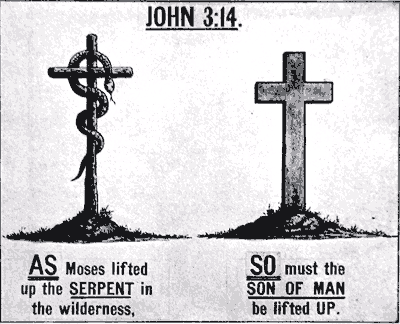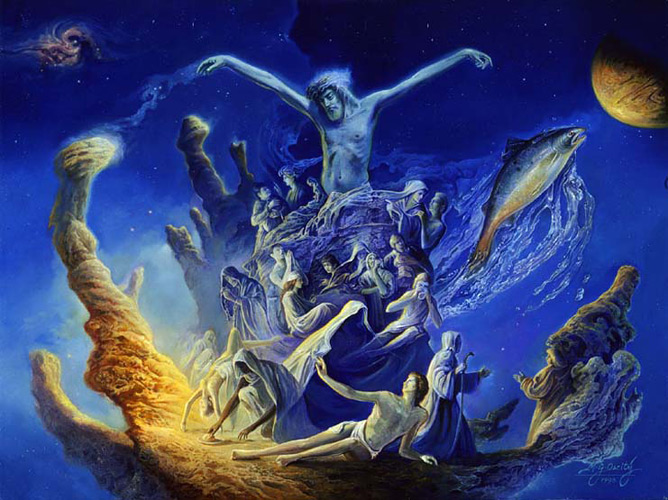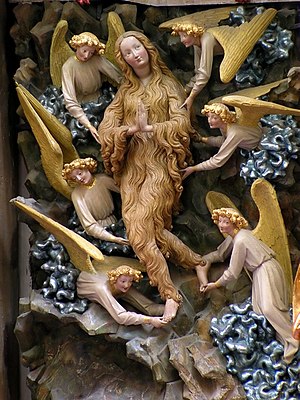Even today there are evidences of Gnostic philosophy in the modern world, but they bear other  names and their true origin is not suspected. Many of the Gnostic concepts have actually been incorporated into the dogmas of the Christian Church, and our newer interpretations of Christianity are often along the lines of Gnostic emanationism – Manly P. Hall The Secret Teachings of All Ages
names and their true origin is not suspected. Many of the Gnostic concepts have actually been incorporated into the dogmas of the Christian Church, and our newer interpretations of Christianity are often along the lines of Gnostic emanationism – Manly P. Hall The Secret Teachings of All Ages
THE entire history of Christian and pagan Gnosticism is shrouded in the deepest mystery and obscurity; for, while the Gnostics were undoubtedly prolific writers, little of their literature has survived. They brought down upon themselves the animosity of the early Christian Church, and when this institution reached its position of world power it destroyed all available records of the Gnostic cultus. The name Gnostic means wisdom, or knowledge, and is derived from the Greek Gnosis.
The members of the order claimed to be familiar with the secret doctrines of early Christianity. They interpreted the Christian Mysteries according to pagan symbolism. Their secret information and philosophic tenets they concealed from the profane and taught to a small group only of especially initiated persons.
 Simon Magus, the magician of New Testament fame, is often supposed to have been the founder of Gnosticism. If this be true, the sect was formed during the century after Christ and is probably the first of the many branches which have sprung from the main trunk of Christianity. Everything with which the enthusiasts of the early Christian Church might not agree they declared to be inspired by the Devil.
Simon Magus, the magician of New Testament fame, is often supposed to have been the founder of Gnosticism. If this be true, the sect was formed during the century after Christ and is probably the first of the many branches which have sprung from the main trunk of Christianity. Everything with which the enthusiasts of the early Christian Church might not agree they declared to be inspired by the Devil.
That Simon Magus had mysterious and supernatural powers is conceded even by his enemies, but they maintained that these powers were lent to him by the infernal spirits and furies which they asserted were his ever present companions. Undoubtedly the most interesting legend concerning Simon is that which tells of his theosophic contests with the Apostle Peter while the two were promulgating their differing doctrines in Rome.
According to the story that the Church Fathers have preserved, Simon was to prove his spiritual superiority by ascending to heaven in a chariot of fire. He was actually picked up and carried many feet into the air by invisible powers. When St. Peter saw this, he cried out in a loud voice, ordering the demons (spirits of the air) to release their hold upon the magician. The evil spirits, when so ordered by the great saint, were forced to obey. Simon fell a great distance and was killed, which decisively proved the superiority of the Christian powers. This story is undoubtedly manufactured out of whole cloth, as it is only one out of many accounts concerning his death, few of which agree. As more and more evidence is being amassed to the effect that St, Peter was never in Rome, its last possible vestige of authenticity is rapidly being dissipated.
That Simon was a philosopher there is no doubt, for wherever his exact words are preserved his synthetic and transcending thoughts are beautifully expressed. The principles of Gnosticism are well described in the following verbatim statement by him, supposed to have been preserved by Hippolytus: “To you, therefore, I say what I say, and write what I write. And the writing is this.
Of the universal Æons [periods, planes, or cycles of creative and created life in substance and space, celestial creatures] there are two shoots, without beginning or end, springing from one Root, which is the power invisible, inapprehensible silence [Bythos]. Of these shoots one is manifested from above, which is the Great Power, the Universal Mind ordering all things, male, and the other, [is manifested] from below, the Great Thought, female, producing all things. Hence pairing with each other, they unite and manifest the Middle Distance, incomprehensible Air, without beginning or end.
In this is the Father Who sustains all things, and nourishes those things which have a beginning and end.” (See Simon Magus, by G. R. S. Mead.) By this we are to understand that manifestation is the result of a positive and a negative principle, one acting upon the other, and it takes place in the middle plane, or point of equilibrium, called the pleroma. This pleroma is a peculiar substance produced out of the blending of the spiritual and material æons. Out of the pleroma was individualized the Demiurgus, the immortal mortal, to whom we are responsible for our physical existence and the suffering we must go through in connection with it.
In the Gnostic system, three pairs of opposites, called Syzygies, emanated from the Eternal One. These, with Himself, make the total of seven. The six (three pairs) Æons (living, divine principles) were described by Simon in the Philosophumena in the following manner: The first two were Mind (Nous) and Thought (Epinoia). Then came Voice (Phone) and its opposite, Name (Onoma), and lastly, Reason (Logismos) and Reflection (Enthumesis). From these primordial six, united with the Eternal Flame, came forth the Æons (Angels) who formed the lower worlds through the direction of the Demiurgus. (See the works of H. P. Blavatsky.) How this first Gnosticism of Simon Magus and Menander, his disciple, was amplified, and frequently distorted, by later adherents to the cult must now be considered.
The School of Gnosticism was divided into two major parts, commonly called the Syrian Cult and the Alexandrian Cult. These schools agreed in essentials, but the latter division was more inclined to be pantheistic, while the former was dualistic. While the Syrian cult was largely Simonian, the Alexandrian School was the outgrowth of the philosophical deductions of a clever Egyptian Christian, Basilides by name, who claimed to have received his instructions from the Apostle Matthew.
Like Simon Magus, he was an emanationist, with Neo-Platonic inclinations. In fact, the entire Gnostic Mystery is based upon the hypothesis of emanations as being the logical connection between the irreconcilable opposites Absolute Spirit and Absolute Substance, which the Gnostics believed to have been coexistent in Eternity. Some assert that Basilides was the true founder of Gnosticism, but there is much evidence to the effect that Simon Magus laid down its fundamental principles in the preceding century.
The Alexandrian Basilides inculcated Egyptian Hermeticism, Oriental occultism, Chaldean astrology, and Persian philosophy in his followers, and in his doctrines sought to unite the schools of early Christianity with the ancient pagan Mysteries. To him is attributed the formulation of that peculiar concept of the Deity which carries the name of Abraxas. In discussing the original meaning of this word, Godfrey Higgins, in his Celtic Druids, has demonstrated that the numerological powers of the letters forming the word Abraxas when added together result in the sum of 365. The same author also notes that the name Mithras when treated in a similar manner has the same numerical value.
Basilides caught that the powers of the universe were divided into 365 Æons, or spiritual cycles, and that the sum of all these together was the Supreme Father, and to Him he gave the Qabbalistical appellation Abraxas, as being symbolical, numerologically, of His divine powers, attributes, and emanations. Abraxas is usually symbolized as a composite creature, with the body of a human being and the head of a rooster, and with each of his legs ending in a serpent. C. W. King, in his Gnostics and Their Remains, gives the following concise description of the Gnostic philosophy of Basilides, quoting from the writings of the early Christian bishop and martyr, St. Irenæus: “He asserted that God, the uncreated, eternal Father, had first brought forth Nous, or Mind; this the Logos, Word; this again Phronesis, Intelligence; from Phronesis sprung Sophia, Wisdom, and Dynamis, Strength.”
In describing Abraxas, C. W. King says: “Bellermann considers the composite image, inscribed with the actual name Abraxas, to be a Gnostic Pantheos, representing the Supreme Being, with the Five Emanations marked out by appropriate symbols. From the human body, the usual form assigned to the Deity, spring the two supporters, Nous and Logos, expressed in the serpents, symbols of the inner senses, and the quickening understanding; on which account the Greeks had made the serpent the attribute of Pallas. His head–that of a cock–represents Phronesis, that bird being the emblem of foresight and of vigilance. His two arms hold the symbols of Sophia and Dynamis: the shield of Wisdom and the whip of Power.”
The Gnostics were divided in their opinions concerning the Demiurgus, or creator of the lower worlds. He established the terrestrial universe with the aid of six sons, or emanations (possibly the planetary Angels) which He formed out of, and yet within, Himself. As stated before, the Demiurgus was individualized as the lowest creation out of the substance called pleroma. One group of the Gnostics was of the opinion that the Demiurgus was the cause of all misery and was an evil creature, who by building this lower world had separated the souls of men from truth by encasing them in mortal vehicles.
The other sect viewed the Demiurgus as being divinely inspired and merely fulfilling the dictates of the invisible Lord. Some Gnostics were of the opinion that the Jewish God, Jehovah, was the Demiurgus. This concept, under a slightly different name, apparently influenced mediæval Rosicrucianism, which viewed Jehovah as the Lord of the material universe rather than as the Supreme Deity. Mythology abounds with the stories of gods who partook of both celestial and terrestrial natures. Odin, of Scandinavia, is a good example of a deity subject to mortality, bowing before the laws of Nature and yet being, in certain senses at least, a Supreme Deity.
The Gnostic viewpoint concerning the Christ is well worthy of consideration. This order claimed to be the only sect to have actual pictures of the Divine Syrian. While these were, in all probability, idealistic conceptions of the Savior based upon existing sculpturings and paintings of the pagan sun gods, they were all Christianity had.
To the Gnostics, the Christ was the personification of Nous, the Divine Mind, and emanated from  the higher spiritual Æons. He descended into the body of Jesus at the baptism and left it again before the crucifixion. The Gnostics declared that the Christ was not crucified, as this Divine Nous could not suffer death, but that Simon, the Cyrenian, offered his life instead and that the Nous, by means of its power, caused Simon to resemble Jesus. Irenæus makes the following statement concerning the cosmic sacrifice of the Christ:
the higher spiritual Æons. He descended into the body of Jesus at the baptism and left it again before the crucifixion. The Gnostics declared that the Christ was not crucified, as this Divine Nous could not suffer death, but that Simon, the Cyrenian, offered his life instead and that the Nous, by means of its power, caused Simon to resemble Jesus. Irenæus makes the following statement concerning the cosmic sacrifice of the Christ:
“When the uncreated, unnamed Father saw the corruption of mankind, He sent His firstborn, Nous, into the world, in the form of Christ, for the redemption of all who believe in Him, out of the power of those that have fabricated the world (the Demiurgus, and his six sons, the planetary genii). He appeared amongst men as the Man Jesus, and wrought miracles.” (See King’s Gnostics and Their Remains.)
The Gnostics divided humanity into three parts: those who, as savages, worshiped only the visible Nature; those who, like the Jews, worshiped the Demiurgus; and lastly, themselves, or others of a similar cult, including certain sects of Christians, who worshiped Nous (Christ) and the true spiritual light of the higher Æons.
After the death of Basilides, Valentinus became the leading inspiration of the Gnostic movement. He still further complicated the system of Gnostic philosophy by adding infinitely to the details. He increased the number of emanations from the Great One (the Abyss) to fifteen pairs and also laid much emphasis on the Virgin Sophia, or Wisdom. In the Books of the Savior, parts of which are commonly known as the Pistis Sophia, may be found much material concerning this strange doctrine of Æons and their strange inhabitants.
James Freeman Clarke, in speaking of the doctrines of the Gnostics, says: “These doctrines, strange as they seem to us, had a wide influence in the Christian Church.” Many of the theories of the ancient Gnostics, especially those concerning scientific subjects, have been substantiated by modern research. Several sects branched off from the main stem of Gnosticism, such as the Valentinians, the Ophites (serpent worshipers), and the Adamites. After the third century their power waned, and the Gnostics practically vanished from the philosophic world.
An effort was made during the Middle Ages to resurrect the principles of Gnosticism, but owing to the destruction of their records the material necessary was not available. Even today there are evidences of Gnostic philosophy in the modern world, but they bear other names and their true origin is not suspected. Many of the Gnostic concepts have actually been incorporated into the dogmas of the Christian Church, and our newer interpretations of Christianity are often along the lines of Gnostic emanationism.
By Manly P. Hall The Secret Teachings of All Ages The Ancient Mysteries and Secret Societies

Moe is the founder of GnosticWarrior.com. He is a father, husband, author, martial arts black belt, and an expert in Gnosticism, the occult, and esotericism.



